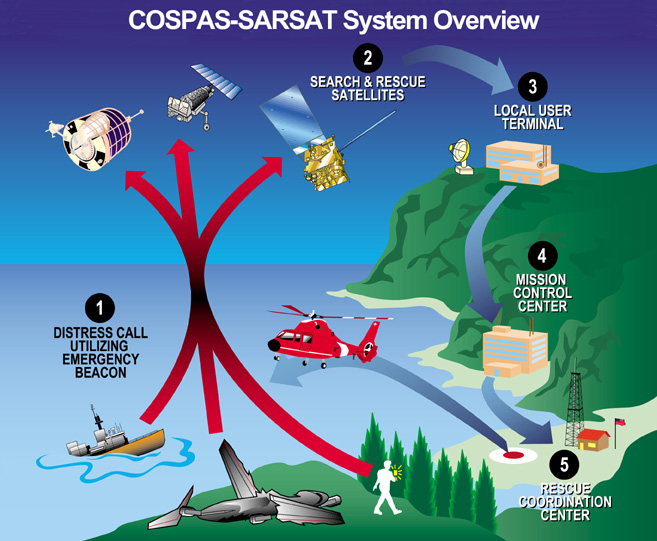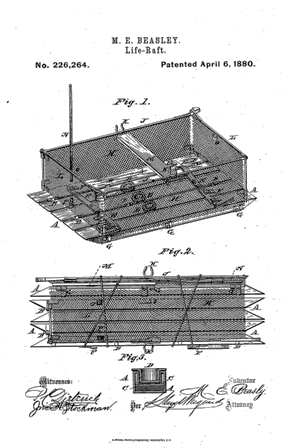|
Lifeboat (shipboard)
A lifeboat or liferaft is a small, rigid or inflatable boat carried for emergency evacuation in the event of a disaster aboard a ship. Lifeboat drills are required by law on larger commercial ships. Rafts (raft, liferafts) are also used. In the military, a lifeboat may double as a whaleboat, dinghy, or Captain's gig, gig. The ship's tenders of cruise ships often double as lifeboats. Recreational sailors usually carry inflatable liferafts, though a few prefer small proactive lifeboats that are harder to sink and can be sailed to safety. Inflatable lifeboats may be equipped with auto-inflation (carbon dioxide or nitrogen) canisters or mechanical pumps. A quick release and pressure release mechanism is fitted on ships so that the canister or pump automatically inflates the lifeboat, and the lifeboat breaks free of the sinking vessel. Commercial aircraft are also required to carry auto-inflating liferafts in case of an emergency water landing; offshore oil platforms also have life ... [...More Info...] [...Related Items...] OR: [Wikipedia] [Google] [Baidu] |
Emergency Position-Indicating Radio Beacon
An emergency position-indicating radiobeacon (EPIRB) is a type of emergency locator beacon for commercial and recreational boats; it is a portable, battery-powered radio transmitter used in emergencies to locate boaters in distress and in need of immediate rescue. In the event of an emergency, such as a ship sinking or medical emergency onboard, the transmitter is activated and begins transmitting a continuous 406 MHz distress radio signal, which is used by search-and-rescue teams to quickly locate the emergency and render aid. The distress signal is detected by satellites operated by an international consortium of rescue services, COSPAS-SARSAT, which can detect emergency beacons anywhere on Earth transmitting on the distress frequency of 406 MHz. The satellites calculate the position or utilize the GPS coordinates of the beacon and quickly pass the information to the appropriate local first responder organization, which performs the search and rescue. As the sea ... [...More Info...] [...Related Items...] OR: [Wikipedia] [Google] [Baidu] |
Lifeboats Of The RMS Titanic
Lifeboats played a crucial role during the sinking of the ''Titanic'' on 14–15 April 1912. The ship had 20 lifeboats that, in total, could accommodate 1,178 people, a little over half of the 2,209 on board the night it sank. 18 lifeboats were used, loading between 11:45 p.m. and 2:05 a.m., though Collapsible Boat A floated off the ship's partially submerged deck and Collapsible Boat B floated away upside down minutes before the ship upended and sank. Many lifeboats only carried a fraction of their maximum capacity which, depending on type, was 40, 47, or 65 people. There are many versions as to the reasoning behind half-filled lifeboats; these included the order of "women and children first", apprehensions that the lifeboats could buckle under the weight, and the fact that many passengers did not feel safe stepping in a lifeboat hovering 90 feet above the freezing ocean and others refused to leave behind family and friends. As the half-filled boats rowed away from the sh ... [...More Info...] [...Related Items...] OR: [Wikipedia] [Google] [Baidu] |
United Kingdom
The United Kingdom of Great Britain and Northern Ireland, commonly known as the United Kingdom (UK) or Britain, is a country in Northwestern Europe, off the coast of European mainland, the continental mainland. It comprises England, Scotland, Wales and Northern Ireland. The UK includes the island of Great Britain, the north-eastern part of the island of Ireland, and most of List of islands of the United Kingdom, the smaller islands within the British Isles, covering . Northern Ireland shares Republic of Ireland–United Kingdom border, a land border with the Republic of Ireland; otherwise, the UK is surrounded by the Atlantic Ocean, the North Sea, the English Channel, the Celtic Sea and the Irish Sea. It maintains sovereignty over the British Overseas Territories, which are located across various oceans and seas globally. The UK had an estimated population of over 68.2 million people in 2023. The capital and largest city of both England and the UK is London. The cities o ... [...More Info...] [...Related Items...] OR: [Wikipedia] [Google] [Baidu] |
Titanic Lifeboat
RMS ''Titanic'' was a British ocean liner that Sinking of the Titanic, sank in the early hours of 15 April 1912 as a result of striking Iceberg that struck the Titanic, an iceberg on her maiden voyage from Southampton, England, to New York City, United States. Of the Sinking of the Titanic#Casualties and survivors, estimated 2,224 passengers and crew aboard, approximately 1,500 died (estimates vary), making the incident one of List of accidents and disasters by death toll#Peacetime maritime, the deadliest peacetime sinkings of a single ship. ''Titanic'', operated by White Star Line, carried some of the wealthiest people in the world, as well as hundreds of emigrants from the British Isles, Scandinavia, and elsewhere in Europe who were seeking a new life in the United States and Canada. The disaster drew public attention, spurred major changes in maritime safety regulations, and inspired a Titanic in popular culture, lasting legacy in popular culture. It was the second time Whit ... [...More Info...] [...Related Items...] OR: [Wikipedia] [Google] [Baidu] |
Maria Beasley
Maria E. Beasley (''née'' Hauser; c. 1836–1913) was an American entrepreneur and inventor. Born in North Carolina, Beasley grew up with a strong interest in mechanical work and learned about the profession of barrel-making from her grandfather. Between 1878 and 1898, she patented fifteen inventions in the United States: these included a footwarmer, an improved life raft, and an anti-derailment device for trains; however, her primary success as an inventor rose from a specialty in barrel-making machines and processes. Beasley licensed a patent to the Standard Oil Company, exhibited her work at the World's Industrial and Cotton Centennial Exposition and the World's Columbian Exposition, and founded two companies for the design and manufacture of barrels (one of which later sold for $1.4 million, the ). Early life Maria Hauser was born in about 1836 in North Carolina to a wealthy family. Her parents were Anna Johanna Spach and Christian Hauser, and Christian was a miller. Mar ... [...More Info...] [...Related Items...] OR: [Wikipedia] [Google] [Baidu] |
Board Of Trade
The Board of Trade is a British government body concerned with commerce and industry, currently within the Department for Business and Trade. Its full title is The Lords of the Committee of the Privy Council appointed for the consideration of all matters relating to Trade and Foreign Plantations, but is commonly known as the Board of Trade, and formerly known as the Lords of Trade and Plantations or Lords of Trade, and it has been a committee of the Privy Council of the United Kingdom. The board has gone through several evolutions, beginning with extensive involvement in colonial matters in the 17th century, to powerful regulatory functions in the Victorian Era and early 20th century. It was virtually dormant in the last third of the 20th century. In 2017, it was revitalised as an advisory board headed by the International Trade Secretary who has nominally held the title of President of the Board of Trade, and who at present is the only privy counsellor of the board, the othe ... [...More Info...] [...Related Items...] OR: [Wikipedia] [Google] [Baidu] |
George Shaw-Lefevre, 1st Baron Eversley
George John Shaw Lefevre, 1st Baron Eversley (12 June 1831 – 19 April 1928) was a British Liberal Party politician. In a ministerial career that spanned thirty years, he was twice First Commissioner of Works and also served as Postmaster General and President of the Local Government Board. Background and education George Shaw Lefevre was the only son of Sir John Shaw Lefevre and Rachel Emily, daughter of Ichabod Wright. He was born in Battersea, and was the nephew of Charles Shaw-Lefevre, 1st Viscount Eversley, Speaker of the House of Commons. He was educated at Eton and at Trinity College, Cambridge, and was called to the Bar, Inner Temple, in 1855. Political career Shaw Lefevre stood unsuccessfully as the Liberal candidate for Winchester in 1859 but was successfully returned for Reading in 1863, a seat he held until 1885. his maiden speech in the House of Commons was made on the ''Alabama'' incident, and in 1868 he was instrumental in calling for arbitration of the ... [...More Info...] [...Related Items...] OR: [Wikipedia] [Google] [Baidu] |
House Of Commons Of The United Kingdom
The House of Commons is the lower house of the Parliament of the United Kingdom. Like the upper house, the House of Lords, it meets in the Palace of Westminster in London, England. The House of Commons is an elected body consisting of 650 members known as Member of Parliament (United Kingdom), members of Parliament (MPs), who are elected to represent United Kingdom constituencies, constituencies by the First-past-the-post voting, first-past-the-post system and hold their seats until Dissolution of the Parliament of the United Kingdom, Parliament is dissolved. The House of Commons of England began to evolve in the 13th and 14th centuries. In 1707 it became the House of Commons of Great Britain after the Acts of Union 1707, political union with Scotland, and from 1801 it also became the House of Commons for Ireland after the Acts of Union 1800, political union of Great Britain and Ireland. In 1922, the body became the House of Commons of the United Kingdom of Great Britain and No ... [...More Info...] [...Related Items...] OR: [Wikipedia] [Google] [Baidu] |
Ship's Boat
A ship's boat is a utility boat carried by a larger vessel. Ship's boats have always provided transport between the shore and other ships. Other work done by such boats has varied over time, as technology has changed. In the age of sail, especially for warships, an important role was the collection of drinking water. The use of radio, followed by telex, e-mail, etc. has reduced and then replaced the need for written communications to be delivered. A large enough boat may be needed to carry an anchor to some distance away from the ship, so as to kedge out of a harbour or away from a hazardand also to recover such an anchor afterwards. Warships have always used their boats as an extension to their military role. This includes the provision of a means of escape for the crews of fireships, the landing of troops, or the "cutting out" raids that were used by the Royal Navy, especially during the Napoleonic Wars. All these requirements competed with the need to be able to stow the b ... [...More Info...] [...Related Items...] OR: [Wikipedia] [Google] [Baidu] |







